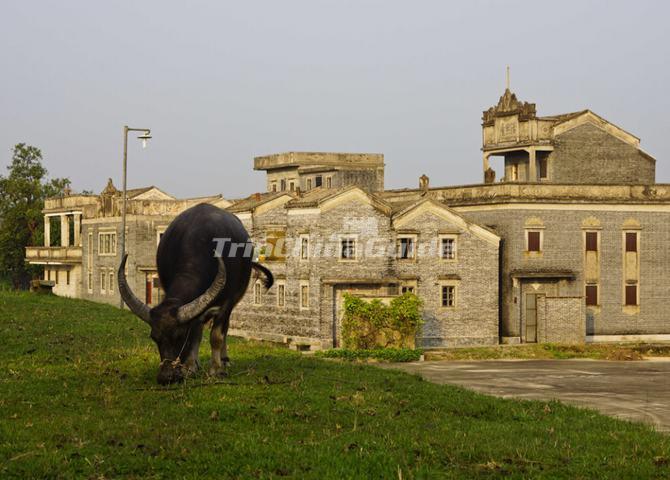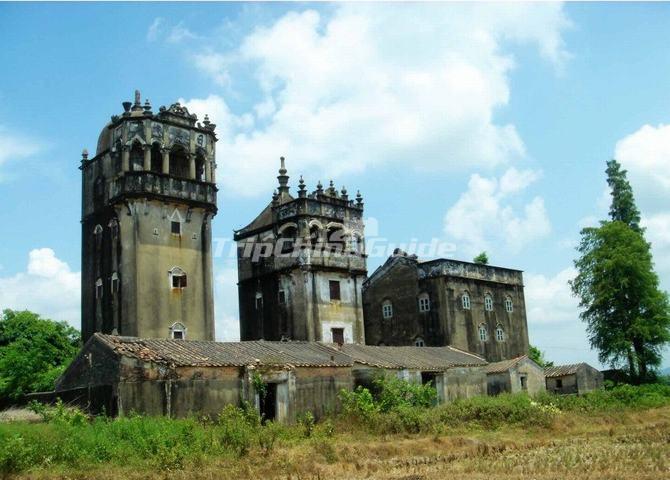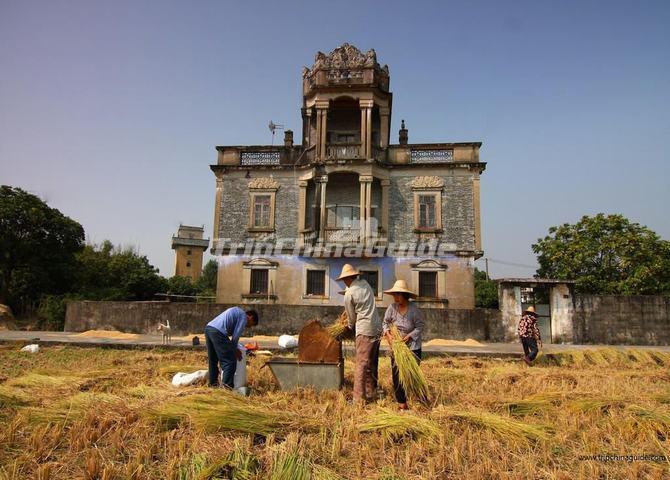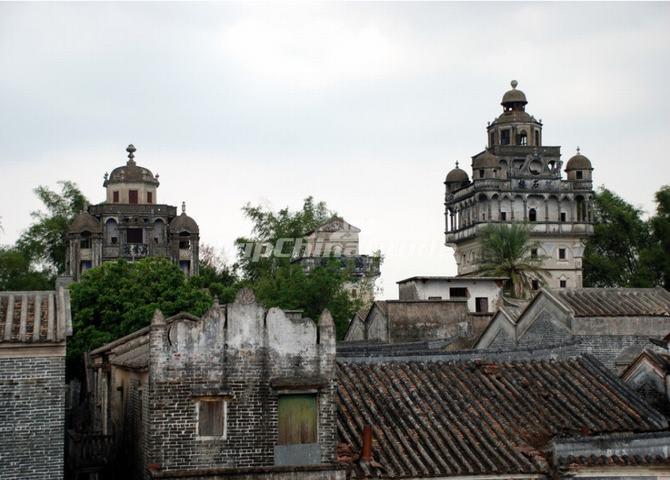Kaiping Diaolou
Kaiping city is located in the southwestern part of the Pearl River Delta. It is 100 km away from Guangzhou in the northeast. Kaiping is one of the renowned homes to overseas Chinese. It is famous for the multifunctional houses with their own style.
Chinese people, especially overseas Chinese, have long been known to have a strong homesick complex. Many of them sent their savings back home. Quite a lot returned to hometown to buy a piece of land, build their own house and get married. In the late Ming and early Qing dynasties, they started to build multi-storied, defensive houses called Diaolou. Do you have any ideas why they made their houses in that way? Here come two main reasons. One is that floods frequently struck this city as it was in a relatively low-lying place. The other is that the city used to have bad social order. Those returned overseas Chinese or those who had relatives abroad were pretty well-off. They suffered a lot from the rampant bandits or gangsters. Diaolou, or watchtower, to put it in the other way, was constructed to solve the aforementioned two problems.
A combination of Chinese and exotic architectural styles is one of the features of the Kaiping Diaolou. The total number of buildings reached 3,300 in its peak time. Nowadays, the number of registered houses is 1,833.
Diaolou is well recognized. Some titles were awarded to it. One is Classic Works Representing the Culture of Overseas Chinese. The second is Showcase of World’s Architectural Art. Diaolou are inscribed upon the list of the National Protection Cultural Relics by the State Council of China. On June 28th, 2007, Kaiping Diaolou and Villages were inscribed on the UNESCO's World Heritage List, and it is the first heritage from Guangdong.
Architectural Style of Kaiping DiaolouKaiping Diaolou enjoys its diversity in function, building materials and styles. When we talk about it function, buildings of this kind take three forms. Firstly, they are residential towers built by individual rich families and used as fortified residences. Secondly, they are communal towers built by several families and used as temporary refuge. Thirdly, they are vigil towers used for time telling and neighborhood security watch. Four kinds of building materials have been used. They are mainly stone, pise, brick or concrete. As I just mentioned, Kaiping people had migrated to live in different parts of the world. Those returned overseas Chinese brought back home exotic ideas and applied them to village house building. This is reflected in the architectural styles of Diaolou. Their watchtowers not only boast ancient Greek and Roman flavors, but also blend Gothic, Ialamic, Baroque and Rococo styles. These buildings feature the harmonious integration of varying foreign architecture patterns and the preference of the house owners.
To fulfill its function to defend against bandits, all the watchtowers have narrow iron doors, small steel windows, and solid walls with embrasures. In some watchtowers, hornworks, locally called "swallow nests", thrust outward on the four corners of the top floor. Those “swallow nests” exert omni-directional control over the surrounding areas. On the top floor of the watchtowers often stand observation posts, equipped with primitive firearms, electric generators, sirens, searchlights, stones, gongs and other defensive devices. From their similar looks and styles, we may say that those watchtowers were mainly used to guard against bandits’ attack.
Kaiping Diaolou have played different roles in different historical periods. In the late stage of China's War of Resistance against Japanese Aggression, some were used as military strongholds. The most famous one was South Watchtower in Tengjiao Village, Chican Town. In the 1920s and 1930s, Kaiping Diaolou were served as secret sites for the Chinese Communist Party to take up underground revolutionary activities. The most renowned two were Shilou and Zhongshanlou.
Distribution SituationWithin Kaiping, most of the Dialou distribute in Zili Village, Majianglong Village Cluster, Sanmenli Village, Jinjiangli Village, Liyuan Garden, and Chikan Old Town.
Diaolou Clusters in Zili VillageZili Village lies in Tangkou Town, about 12 kilometers from Kaiping city center. It enjoys the most exquisite, best-preserved, densely located buildings of such kind. Fifteen houses in existence in this village are all ranked as cultural relics of national importance under the protection of the state. Mingshilou, a five-storey residential house, is the fanciest. It was built in 1925, made of armored concrete. At its top stands a hexagonal observation tower, displaying a fusion of Chinese and western structural and decorative forms. On every corner of its fifth floor rises a hornwork. Local people called them "Swallow nest". As you can see, this house has a massive body, solid iron doors and windows. It has quality designed furnishings and complete living facilities.
 Diaolou Clusters in Majianglong Villages
Diaolou Clusters in Majianglong Villages
Majianglong was apparently praised as the "world's most beautiful cluster of villages" by UN. It lies in Baihe township 20 km from Kaiping city. There are five separate villages which unite to form the village cluster: Yong'an, Nan'an, Hedong, Qinglin, and Longjiang. The 13 Diaolou here are very well preserved and range from 2-7 stories tall. They fuse Chinese, British and German and European styles and are built using reinforced concrete and brick.
















